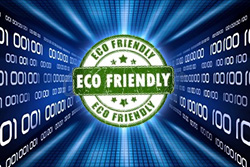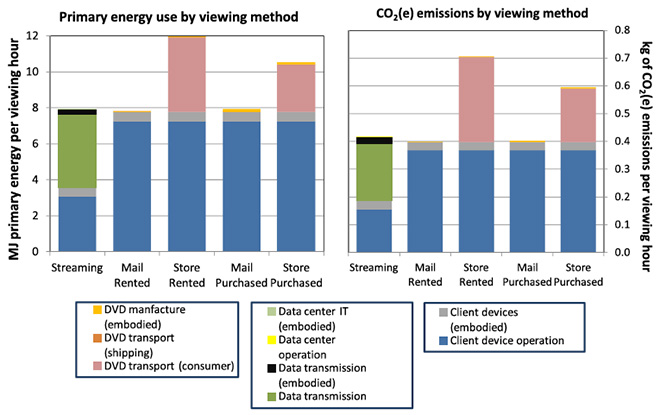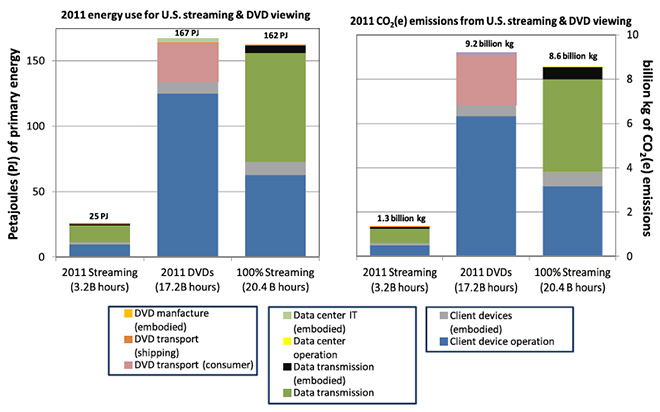Europe's online source of news, data & analysis for professionals involved in packaged media and new delivery technologies

Is video streaming 'greener' than packaged media? It depends
It is an article of faith in the environmental community that the sooner we get rid of packaged media - whose manufacture produces quantities of CO2 - and switch to eco-friendly video streaming the better. But is it true?
Three scholars, Arman Shehabi, from the Lawrence Berkeley National Laboratory in California, and Ben Walker and Eric Masanet, from Northwestern University in Illinois, examined in detail the evidence in a recently-published paper The energy and greenhouse-gas implications of internet video streaming in the United States. Accounting for a wide range of variables, the results make for surprising reading.
The rapid growth of streaming video entertainment has recently received attention as a possibly less energy intensive alternative to the manufacturing and transportation of DVDs. This study utilizes a life-cycle assessment approach to estimate the primary energy use and greenhouse-gas emissions associated with video viewing through both traditional DVD methods and online video streaming. Estimates for 2011 video viewing energy and CO2 emissions indicate video streaming can be more efficient than DVDs, depending on DVD viewing method. Video streaming benefits from relatively more efficient end-user devices than DVD viewing, though much of that savings is lost when accounting for the additional energy from network data transmission, especially if it is to accommodate HDTV, not to mention 4K UHD.
The energy efficiency of video streaming compared to DVD viewing depends on the DVD viewing method. Streaming is more efficient than store-rented or store-purchased DVDs, owing to the impact associated with consumer driving. However, streaming appears similar in efficiency to mail-delivered DVD viewing.
Energy consumption and CO2 emissions take place throughout the supply chain of both packaged and streaming methods of video content delivery.
The energy associated with the manufacturing and shipping of the DVDs themselves (excluding consumer transport) only account for about 1-2% of the total energy use for purchased DVDs, and well below 1% for rented DVDs, indicating that even significant increases in shipping impact (e.g., long distance air-mail express delivery) have minimal impact on the overall energy demand and CO2 emissions.

In both streaming and DVDs viewing, it is the operational energy use required for end-user devices - DVD player, game console, settop box, desktop computer, laptop, smartphone, tablets, TV set, flat screen monitor - that dominates the energy demand, accounting for nearly all of the energy use associated with mail-delivered DVD viewing. The research shows that the noticeable drop in end-user device energy for video streaming is due to a shift away from older less efficient DVD players, which typically have significant idle energy demand while also being devices dedicated for the single purpose of DVD viewing.
The improvement in end-user device energy with video streaming (settop boxes) is nearly offset by the energy dedicated to the data transmission network. About 90% of the streaming video energy is dedicated to operating both end-user devices and the data transmission network.
The paper presents the hypothetical energy use and CO2 emissions if the amount of hours of DVD viewing were shifted entirely to streaming video, which is indicative of the trend away from DVDs an toward streaming that is underway.
In this case, a total of 20.4 billion hours of streaming would occur in the US, where such a shift to streaming video represents a potential energy savings of almost 30 petajoule (PJ) and about 2 billion kg of avoided CO2 emissions compared to the case for DVDs. Much of the energy use reduction in shifting from DVD to streaming video is due to the change in end-user devices away from DVD players. The researchers notes that, interestingly, the results points to the fact that the total energy use for the data transmission of streaming video would be greater than the energy associated with the current transport of DVDs.

The energy consumption and CO2 emissions in the case of video streaming depends on the data transfer rate, the network energy intensity, and the power demand of end-user devices. The data transfer rate is shown to create a wide range of potential CO2 emissions when varied from the low case of 1 Mbps, representing standard definition streaming, to the high case of 6 Mbps, like Netflix's Super HD streaming rate.
To place these streaming rates in context, digital high definition video downloads typically have files size around 2 GB per hour of video, representing an equivalent streaming rate of about 4.5 Mbps. The researchers say that significant increase in CO2 emissions associated with the higher data transfer rates highlights that improvements in network energy efficiency must accompany any future increases in data transfer rates for streaming video to remain a lower energy and CO2 alternative to DVD viewing.
The 'greening' of packaged media is conceivable is well. Possible future increases in DVD equipment efficiency, urbanization (i.e., shorter driving distances), advances in vehicle efficiency, and more environmentally conscious consumer driving trips could significantly reduce the energy and CO2 emissions associated with all methods of DVD viewing.
The study is based on the assumption that streaming video and disc-based video offer the same utility (satisfaction) to consumers. The researchers accept that it is not necessarily the case. While video streaming quality is rapidly improving, DVDs still offer a higher quality video and audio service (in the form of Blu-ray discs). While Netflix's maximum Super HD streaming rate is 6 Mbps, the typical streaming rate of a Blu-ray disc is approximately 20 Mbps.
The quality gap between streaming and DVD video may continue to close with improved data compression technology, however, say the authors of the study, if more complex video platforms gain popularity in the marketplace (i.e., ultra high definition or 3D video), streaming video may require greater data transfer rates while the change in manufacturing and transport of physical media would be minimal.
This points to Blu-ray Discs as the ideal - 'greener' - platform for 4K!
The full article can be downloaded here .
Story filed 20.06.14




















